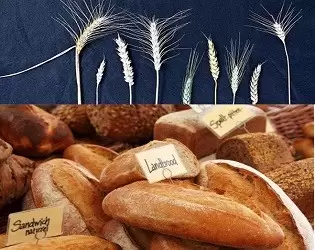
Views: 15
– Bread wheat is enormously adaptable to different regional conditions. Its great genetic diversity is the result of the crossing of numerous chromosomal fragments of wild grasses.
Courtesy UZH: The result of the study shows the genome sequences of ten wheat varieties from four continents, which an international consortium with the participation of researchers from the University of Zurich has already deciphered.
A variety of bread wheat that thrives splendidly in Switzerland remains poor grass in India. This adaptability to regional climatic conditions and environmental factors makes wheat the most important crop in the world. It was cultivated for about 8,000 years. Since then, more than 560,000 different varieties have been created, which are stored in international seed banks. The genetic basis responsible for the diversity and adaptability of wheat was largely unknown until now.
Genome of ten varieties of wheat completely determined
Only the genome of an ancient local Chinese variety has been deciphered so far. For many years, it served as a research plant as a model, but it differs greatly from the properties of modern agricultural varieties of wheat.
Now, an international consortium led by the University of Saskatchewan with more than 100 researchers from nine countries – including plant and evolutionary biologists from the University of Zurich (UZH) – has the genetic makeup of ten bread wheat varieties from North America, Asia, Australia and Europe in full and in large quantities Sequenced quality.
“The ten varieties represent a significant part of the world’s wheat diversity. Genome data, which is freely available to all interested parties, represents an important resource for humanity, ”says Beat Keller, professor at the UZH Institute of Plants and Microbiology.
Chromosome fragments of wild grasses crossed
With about 100,000 genes on 21 chromosomes, the wheat genome is about five times larger than the human. Like other types of grains, today’s bread wheat has a multiple set of chromosomes that are created by hybridizing and fusing three different parent plants.
“We were able to find numerous differences in the genome structure of the wheat varieties examined. They differ in particular in the large chromosome fragments that were crossed with wild grasses at some point in the past ”, adds researcher Thomas Wicker of UZH, one of the last authors of the study.
Although some of these fragments were transferred to wheat through targeted crosses, the origin of most fragments is still unknown.
Exceeding species limits leads to diversity
If fragments of chromosomes from wild grasses cross into wheat, the species limit is exceeded. According to scientists, this process is an important biological basis for the diversity and adaptability of the grain.
This is exemplified by the large differences in the type and number of immune receptors that they discovered in the genome sequences. “This variability shows that the different varieties have adapted to plant diseases in different regions, such as viruses and fungi, or pests, such as insects”, says Wicker.
Ensure growing demand thanks to more targeted creation
According to Kentaro Shimizu, professor at UZH at the Institute for Evolutionary Biology and Environmental Sciences, the triple set of chromosomes gives wheat another evolutionary advantage: “Individual genes can change, while other copies of the same genes retain their original function.
The plant, therefore, has a greater repertoire of possibilities and is more adaptable. “As UZH researchers show in an additional publication using the example of the Japanese bread and wheat variety” Norin 61 “, the” 10+ Wheat Genome Project “, allows not only the discovery of agronomically important genes for quality and resistance traits , but also the improvement of wheat varieties in a more targeted way to meet the growing global demand to guarantee demand also in the future.
References:
Sean Walkowiak, Liangliang Gao, Cecile Month et. al. Various wheat genomes reveal global variation in modern breeding. Nature. November 25, 2020. DOI: 10.1038 / s41586-020-2961-x
Kentaro K. Shimizu, Dario Copetti, Moeko Okada, Thomas Wicker et al. The De Novo genome set of the Japanese wheat cultivar Norin 61 highlights functional variation at the time of flowering and Fusarium resistance genes in East Asian genotypes. Plant and Cell Physiology. November 2020. DOI: 10.1093 / pcp / pcaa152
Project Financing
The Swiss variety “ArinaLrFor” was also among the ten wheat genomes that were decoded. The project was funded by the Federal Secretariat of Agriculture FOAG, UZH and the associations and companies in the areas of wheat improvement, wheat production and bakery industry.
The Japanese variety “Norin 61” was deciphered by UZH researchers in collaboration with Japan’s Science and Technology Agency JST.
Contact:
PD Dr. Thomas Wicker Prof. Dr. Beat Keller
Tel. +41 44 634 82 52 Tel. +41 44 634 82 30
Email: wicker@botinst.uzh.ch Email: bkeller@botinst.uzh.ch Institute of Plants and Microbiology Zurich University
Prof. Dr. Kentaro K. Shimizu
Tel. +41 44 635 67 40
Email: kentaro.shimizu@ieu.uzh.ch Institute of Evolutionary Biology and Environmental Sciences Zurich University
Related article: Ozone – Exhaust gas is to blame: Ground-level ozone is damaging crops